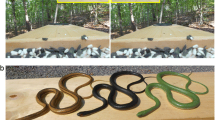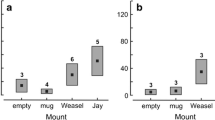Abstract
The predatory behaviour of eight wild adult common kestrels (Falco tinnunculus) was recorded during predatory tests carried out in the wild under controlled conditions. Those birds were offered one laboratory mouse each, which was restrained on a base, thereby simulating natural predation. The predatory sequence was recorded directly, but also video-taped. The sequence was rather homogeneous among the kestrels, with most kestrels starting the attack glide from a perch, then capturing the prey at high speed. The mouse was grabbed directly, upon landing; in one instance, however, it disentangled from the bird’s foot and was captured after a few seconds. The target was usually grabbed at the shoulders or neck, or at the trunk. Soon after capture the kestrel flew to a distant perch, where it usually stroked the prey with one single peck, before starting ingestion, which began about 1 min time after prey grasping. Our results are the first to show the possibility of maintaining standardized conditions to study the predatory behaviour of birds of prey. As they are very similar to those obtained in previous tests carried out in captivity using rehabilitated kestrels, our results also confirm earlier ones showing that the kestrel’s predatory behaviour is rather stereotyped—i.e. performed with limited variation—and that it can be studied reliably even in captivity.
Similar content being viewed by others
References
Aparicio JM (2000) Differences in the diets of resident and non-resident kestrels in Spain. Ornis Fennica 77:169–175
Association for the study of animal behaviour, Animal Behavior Society (2001) Guidelines for the treatment of animals in behavioural research and teaching. Anim Behav 61:271–275
Bishop YMM, Fienberg SE, Holland PW (1975) Discrete multivariate analysis. Theory and practice. MIT Press, Cambridge
Brown L (1989) British birds of prey. Bloomsbury Books, London
Csermely D (1993) Duration of rehabilitation period and familiarity with the prey affect the predatory behaviour of captive wild kestrels, Falco tinnunculus. Boll Zool 60:211–214
Csermely D (1994) Does prey size affect predatory behaviour of kestrel? Avocetta 18:63–67
Csermely D (2004) Lateralisation in birds of prey: adaptive and phylogenetic considerations. Behav Process 67:511–520
Csermely D, Bagni L (2003) The predatory behaviour of common kestrels facing various types of prey. J Ethol 21:107–110
Csermely D, Gaibani G (1998) Is the foot squeezing pressure by two raptor species a tool used to subdue their prey? Condor 100:757–763
Csermely D, Mainardi D, Agostini N (1989) The predatory behaviour of captive wild kestrels, Falco tinnunculus. Boll Zool 56:317–320
Csermely D, Bertè L, Camoni R (1998) Prey killing by Eurasian kestrels: the role of the foot and the significance of bill and talons. J Avian Biol 29:10–16
Huntingford FA (1984) Some ethical issues raised by studies of predation and aggression. Anim Behav 32:210–215
Kübler S, Kupko S, Zeller U (2005) The kestrel (Falco tinnunculus L.) in Berlin: investigation of breeding biology and feeding ecology. J Ornithol 146:271–278
Lihu X, Jianjian L, Chunfu T, Wenshan H (2007) Foraging area and hunting technique selection of common kestrel (Falco tinnunculus) in winter: the role of perch sites. Acta Ecol Sinica 27:2160–2166
Riegert J, Fuchs R (2003) Individual hunting behaviour of urban kestrels (Falco tinnunculus). In: Proc 6th World Conf Birds Prey Owls. Budapest, p 1
Salvati L, Manganaro A, Fattorini S, Piattella E (1999) Population features of kestrels Falco tinnunculus in urban, suburban and rural areas in central Italy. Acta Ornithol 34:53–58
Shrubb M (1993) The kestrel. Hamlyn, London
Still AW (1982) On the number of subjects used in animal behaviour experiments. Anim Behav 30:873–880
Videler JJ, Weihs D, Daan S (1983) Intermittent gliding in the hunting flight of the kestrel Falco tinnunculus. J Exp Biol 102:1–2
Village A (1990) The kestrel. T&AD Poyser, London
Acknowledgments
We thank the Parma Provincial Administration for permission to study the wild kestrels on its territory. We appreciate the improvements in English usage made by Jen Johnson through the Association of Field Ornithologists’ program of editorial assistance, led by Daniel M. Brooks as well as the constructive comments and suggestions from two anonymous reviewers on an earlier version of the manuscript. The research was supported by the Italian Ministero dell’Università e della Ricerca.
Author information
Authors and Affiliations
Corresponding author
About this article
Cite this article
Csermely, D., Bonati, B. & Romani, R. Predatory behaviour of common kestrels (Falco tinnunculus) in the wild. J Ethol 27, 461–465 (2009). https://doi.org/10.1007/s10164-008-0143-7
Received:
Accepted:
Published:
Issue Date:
DOI: https://doi.org/10.1007/s10164-008-0143-7




